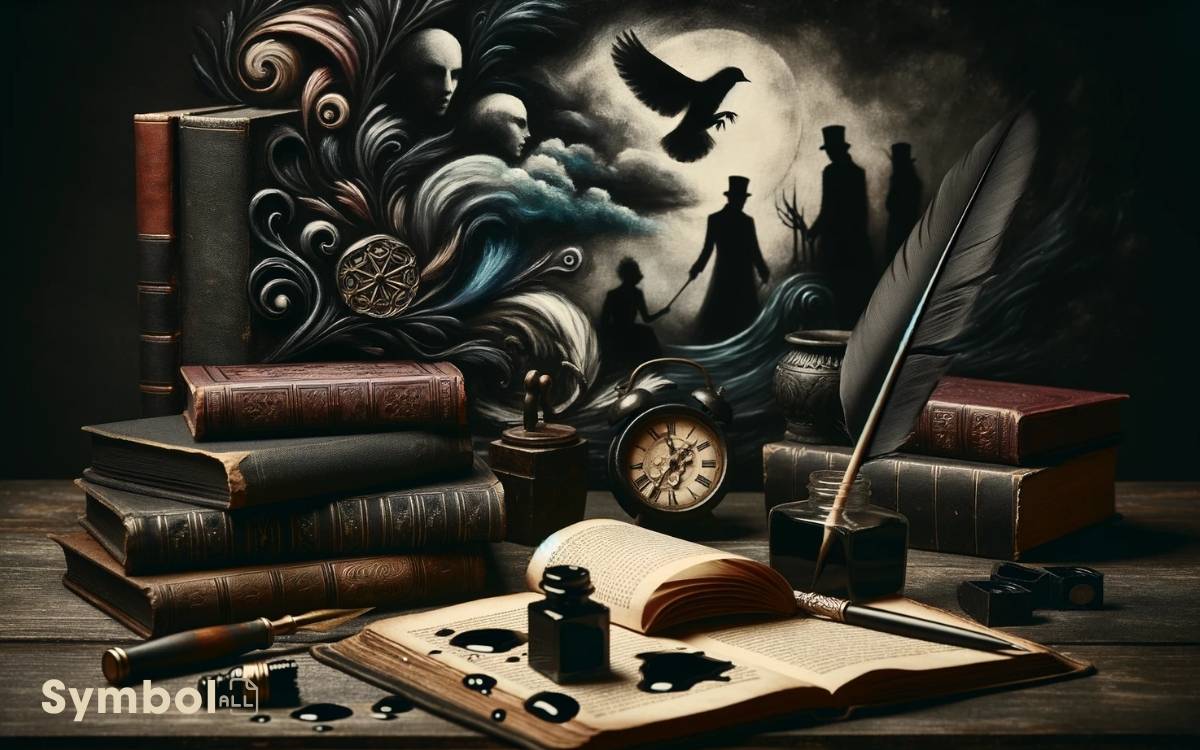What Does the Color Black Symbolize in Literature? A Guide!
In literature, you’ll find the color black dripping with symbolism. It’s the veil of the unknown, shrouding characters in mystery and compelling you to peer deeper into their psyche.
It’s the solid ground of mourning, where grief and loss are palpable, resonating with your own encounters of despair.
Black holds power, signaling authority and dominance, but it also whispers of rebellion and defiance. It’s the depth of night, where evil lurks and tension builds, pushing you to the edge of your seat.
Within its elegance lies a sophistication waiting to unfold, revealing layers of meaning that connect deeply with the human experience. As you uncover these layers, you’re invited to a universe of meaning awaiting discovery.

Key Takeaway
The Mystery of Black
Black, often shrouded in an aura of profound mystery, serves as a canvas upon which authors paint the unknown and the unfathomable.
You’ll find that in literature, this enigmatic hue isn’t simply a color but a symbol that explores deeply into the human psyche. It represents the uncharted territories of the mind and the secrets that lie buried within the soul.
As you explore different literary works, you’ll notice black’s ability to evoke a sense of intrigue and curiosity. It’s not just about the absence of light or color; it’s about what lies beneath the surface, waiting to be discovered.
Black challenges readers to look beyond the obvious, encouraging a deeper, more introspective form of analysis.
Essentially, it’s a color that compels you to question, to ponder, and ultimately, to understand the complexities of the narrative.
Mourning and Loss
Throughout literature, the color black has been frequently employed to symbolize mourning and loss, evoking a visceral response in readers as they navigate through narratives of grief and sorrow.
This dark hue serves as a universal marker of despair, effectively communicating the depth of characters’ suffering without the need for extensive dialogue or description.
Its presence often foreshadows the emotional turmoil that follows, subtly preparing you for the unfolding tragedy.
By embracing black’s symbolic weight, authors craft scenes that resonate on a deeply emotional level, allowing you to empathize with the characters’ experiences of bereavement and desolation.
This use of color not only enriches the narrative but also bridges the gap between the text and your own encounters with grief, making the stories profoundly relatable and poignant.
Power and Authority
While often associated with mourning and loss, the color black also embodies a profound sense of power and authority in literature, inviting you to explore its dual significance in shaping characters and narratives.
When authors dress their characters in black, they’re not merely choosing a color; they’re imbuing those characters with an aura of dominance and control.
This use of black transcends mere fashion, acting as a visual shorthand for the character’s influence within the story.
Similarly, settings draped in darkness or described with heavy use of black tones often hint at the presence of a powerful force, whether it be a person, institution, or even an abstract concept.
Through these deliberate choices, writers leverage the color black to convey complex ideas about power dynamics, leadership, and governance, drawing you into a deeper understanding of the narrative’s underlying themes.
Evil and Menace
You’ll find that black often embodies the most sinister aspects of the narrative, symbolizing malevolent forces with a depth that’s both intriguing and foreboding.
Its pervasive presence in literature serves as a stark contrast, where darkness overwhelms goodness, creating a palpable tension that propels the story forward.
This color’s usage as fear’s visual representation enriches the text, offering layers of meaning that invite rigorous analysis.
Symbolizing Malevolent Forces
In literature, black often serves as a powerful symbol for evil and menace, casting a shadow over characters and plots with its dark associations.
This color embodies the essence of malevolence, subtly exploring through narratives to suggest the presence of sinister forces at play.
You’ll find that black doesn’t merely represent evil in a straightforward manner; it’s more nuanced, suggesting the depth and complexity of malevolent entities.
| Aspect | Significance |
|---|---|
| Shadows | Concealment of evil intentions |
| Dark Cloaks | Anonymity of malevolent figures |
| Nighttime | Peak of malevolent activities |
Through these elements, black enriches stories, inviting you to plunge deeper into the psychological and symbolic layers of the text. It’s not just a color; it’s a narrative device that heightens the sense of threat and mystery.
Darkness Overwhelms Goodness
Amidst the battle between light and dark, black’s dominance in literature often signifies how evil can utterly overwhelm goodness.
This concept isn’t superficial; rather, it digs deeply into the human psyche, exploring the profound impact of malevolence on the human spirit and the world.
When authors drape their worlds or characters in black, they’re not just choosing a color; they’re invoking the overwhelming power of darkness to consume light, to overshadow hope with despair.
This isn’t merely about the presence of evil but its ability to dominate, to transform landscapes and lives into reflections of its essence.
It’s a stark reminder of the fragility of goodness in the face of a pervasive darkness, challenging readers to confront the real potential for darkness to prevail.
Fears Visual Representation
Moving beyond the overarching dominance of darkness, it’s imperative to explore how black serves as a visual representation of fears, embodying both evil and menace in literature.
Through its stark contrast to lighter hues, black encapsulates the unknown, the unseen, and the unfathomable depths of the human psyche. It’s not merely a color; it’s a symbol loaded with connotations. Its profound allure has made it a cornerstone in art, fashion, and cultural identity, often serving as a canvas for self-expression and deeper meaning. For instance, black sorority colors and symbols frequently intertwine tradition, heritage, and unity, infusing a sense of pride and purpose into their design. This rich interplay of symbolism illustrates how black extends beyond mere aesthetics to embody resilience, mystery, and empowerment.
When you encounter black in literary works, you’re often probing into the characters’ deepest anxieties, the lurking evils that threaten their world, or the ominous presence of an antagonist.
This color transcends its visual significance, becoming a tool for authors to investigate the complexities of fear, to paint their narratives with the brush of suspense, and to evoke a visceral response from you, the reader, as you navigate through the shadows of the story.
The Unknown and Unseen
In literary contexts, the color black often envelopes characters in a shroud of mystery, signifying the vast, unexplored territories of the human psyche and the cosmos.
You’ll find that authors leverage this hue to evoke a primal fear of the dark, a space where hidden dangers and the unknown lurk, challenging characters and readers alike to confront their deepest anxieties.
This symbolism invites a deeper understanding of how the unseen forces in narratives drive the plot and develop characters, hinting at the pervasive influence of the unseen in the tangible world.
Fear of the Dark
The fear of the dark, often symbolized by the color black in literature, taps into the primal human dread of the unknown and unseen, challenging readers to confront their deepest anxieties.
This evocative use of black peels back the layers of comfort we wrap around ourselves, revealing an underlying vulnerability to that which we can’t perceive or understand.
Literature harnesses this powerful symbol to explore themes of ignorance, uncertainty, and the subconscious, weaving a complex tapestry that mirrors our internal struggles with fear.
By presenting characters who grapple with the darkness—both literal and metaphorical—authors invite you to reflect on your own reactions to the unknown, encouraging a deeper understanding of the human condition and the psychological landscapes we navigate.
Hidden Dangers Lurk
While literature often uses the color black to symbolize the fear of the dark, it also explores the theme of hidden dangers that lurk within the unknown and unseen, challenging you to confront the unsettling truth that what isn’t visible can still profoundly affect us.
This theme invites analysis on multiple levels, demonstrating that:
- Characters often face threats not from known adversaries, but from unseen forces that are more difficult to combat.
- The unknown compels characters to confront their deepest fears and insecurities.
- Black’s association with the unseen symbolizes the vast, uncharted territories of the human psyche.
- It reminds you that ignorance or denial of these hidden dangers only magnifies their power over us.
This scholarly approach illuminates the depth of black’s symbolism, enriching your understanding of its role in literature.
Elegance and Sophistication
Black often embodies elegance and sophistication in literature, offering a nuanced canvas upon which authors paint characters and scenes of refined complexity.
This color isn’t just a shade; it’s a symbol of the intricate layers that define the human condition. Through its use, you’re invited to explore further into the narrative, uncovering the subtleties of societal norms and the personas that navigate them.
Black’s representation extends beyond mere aesthetics; it encapsulates the essence of sophistication, manifesting in the attire of characters, the settings of opulent soirees, or the shadowy veneer of mystery enveloping a plot.
It’s a deliberate choice by authors to evoke a sense of timeless grace, urging you to appreciate the elegance that can only be articulated through the profound simplicity of black.
Rebellion and Anarchy
In literature, you encounter black as a stark symbol of resistance, often embodying characters’ and movements’ defiance against established norms.
Its deep roots in anarchy highlight a rich history of challenging authority figures, reflecting a profound critique of societal structures.
This color’s association with rebellion underscores not just a desire for change, but a deep-seated demand for reevaluation of power dynamics.
Symbols of Resistance
Throughout literary history, the color black has often served as a potent symbol of resistance, embodying themes of rebellion and anarchy against established norms.
When you explore literature, you’ll find that black represents a defiance against conformity, offering a rich tapestry of meanings:
- Empowerment: Black symbolizes the power and autonomy of characters challenging societal constraints.
- Mystery: It often cloaks rebels in an aura of mystery, making their motives and actions unpredictable.
- Solidarity: Black unifies individuals under a common cause, signifying collective resistance.
- Protection: It provides a metaphorical shield against persecution, safeguarding the identities and intentions of those who dare to defy.
This nuanced symbolism invites you to appreciate the depths of resistance within literary narratives, revealing how black transcends mere color to embody a complex spectrum of defiance against oppression.
Anarchys Deep Roots
Digging deeper into the symbolism of black, we find its roots intertwined with rebellion and anarchy, reflecting a profound connection to movements that challenge the status quo.
This color’s association with anarchy isn’t merely superficial; it signifies a deep-seated disdain for systemic oppression and a yearning for liberation.
Black embodies the void from which new beginnings can emerge, suggesting that out of chaos comes the opportunity for radical change.
In literature, characters draped in black often signal a break from conventional norms, hinting at their role as agents of upheaval.
This color’s usage is a deliberate choice, signaling a narrative’s engagement with themes of power, autonomy, and the quest for societal transformation. It’s a visual cue that you’re about to explore the complexities of freedom and constraint.
Challenging Authority Figures
Why do characters cloaked in black so often stand at the forefront of challenging authority figures, embodying both rebellion and anarchy in literature?
The color black serves as a powerful symbol of dissent, reflecting a deep-seated defiance against established norms. It’s not just a matter of aesthetics; it’s a deliberate choice that speaks volumes about the character’s inner turmoil and their stand against oppression.
Here’s why:
- Black represents the unknown, suggesting characters are venturing into uncharted territories of dissent.
- It embodies resistance, offering a stark contrast to the purity and order white often symbolizes.
- Black signifies strength and determination, traits essential for those challenging the status quo.
- It visually isolates the rebel, highlighting their outsider status and the solitude of their path.
In essence, black isn’t just a color; it’s a statement.
The Void and Emptiness
In literature, black often embodies the concept of void and emptiness, creating a profound sense of absence and desolation.
This color isn’t just a lack of light; it’s a symbol for the unoccupied spaces in our souls, the gaps left by loss or unfulfilled desires.
Black invites you to ponder what’s missing, offering a canvas where nothingness becomes palpable.
| Aspect | Significance in Literature |
|---|---|
| Absence of Light | Symbolizes unknown, unseen fears |
| Infinite Space | Implies existential emptiness |
| Silence | Represents unspoken, hidden truths |
Through these attributes, black doesn’t just depict emptiness; it asks you to explore the depths of the unseen and the unspoken, making you aware that within the void, there lies a universe of meaning, awaiting discovery.
Fertility and Rebirth
Contrary to its common associations with void and desolation, black also heralds themes of fertility and rebirth in literature, symbolizing the fertile soil from which new life springs forth.
This rich symbolism invites you to explore its depths through the following aspects:
- Narrative Transformation: Characters often undergo a metaphorical death and rebirth, emerging from ‘black’ phases of their lives renewed.
- Seasonal Cycles: Black signifies the end of one cycle and the beginning of another, embodying nature’s perpetual renewal.
- Emotional Depth: It represents profound emotional growth, akin to the richness of the earth that fosters new life.
- Cultural Significance: In many cultures, black is a color of regeneration, tied to rituals and stories that emphasize rebirth and renewal.
This perspective enriches your understanding of black’s multifaceted symbolism in literary contexts.
Protection and Comfort
Beyond its somber connotations, black also envelops a sense of protection and comfort, serving as a literary shield against the external chaos.
This color, often associated with night, offers a backdrop for introspection and solace, allowing characters to cloak themselves in an invisible armor.
In literature, black’s protective quality isn’t merely physical; it extends to the psychological domain, offering a sanctuary from the tumult of the external world.
Authors weave this color into their narratives to suggest a cocooning effect, where characters find respite and strength within their darkest moments.
This duality of black, as both a harbinger of despair and a bastion of comfort, invites readers to explore further into the complexities of human emotion, challenging one-dimensional interpretations and revealing the nuanced interplay between darkness and light.
Identity and Anonymity
Exploring further, the color black also profoundly impacts notions of identity and anonymity in literature, serving as a veil that either obscures or reveals the depths of a character’s essence.
Here’s how:
- Concealment: Black often cloaks characters in mystery, allowing them to navigate stories without revealing their true selves until a pivotal moment.
- Uniformity: In dystopian narratives, black attire can symbolize the erasure of individuality, pushing characters towards a collective identity.
- Transformation: Characters donning black may signal a shift in identity or allegiance, marking their evolution or regression within the narrative arc.
- Isolation: Black can also isolate characters, setting them apart and underscoring their uniqueness or alienation within the story.
This nuanced use underscores black’s power to both shield and signify identity in literature.
Depth of the Psyche
Delving into the depths of the human psyche, the color black often mirrors the complex, hidden layers of our innermost thoughts and emotions in literature.
It’s a hue that’s both enigmatic and profoundly significant, serving as a lens through which we explore the intricacies of the mind and soul.
| Symbolism | Implication |
|---|---|
| Hidden Desires | Revealing the secrets within. |
| Unconscious Mind | Journeying through unknown territories. |
| Inner Conflicts | The struggle between opposing forces. |
| Self-Reflection | A voyage inward to discover true self. |
| Emotional Depths | Exploring the vast ocean of feelings. |
Endings and Beginnings
In literature, the color black often symbolizes both the finality of endings and the mysterious potential of new beginnings, inviting readers to reflect on the cyclical nature of life and narrative.
To deepen your appreciation, consider these aspects:
- Closure: Black marks the end of a journey, offering a stark, definitive conclusion that leaves no room for ambiguity.
- Transition: It also hints at the unseen possibilities lying ahead, suggesting that every ending paves the way for a new start.
- Renewal: Like the soil that both absorbs all and gives life, black embodies the promise of growth and renewal after decay.
- Reflection: This duality prompts introspection, encouraging you to explore the depths of your own experiences with endings and beginnings.
Conclusion
As you’ve journeyed through the shadowy domains of black in literature, you’ve seen its power to cloak the soul in mystery, to mourn, to intimidate, and to menace.
Yet, it also embraces in protection, cloaks in anonymity, and whispers of deep, uncharted psyches.
Like the silent stroke of midnight, it marks endings and births new beginnings. Black, in its enigmatic splendor, weaves a tapestry rich with complexity, inviting you to look beyond the veil, to see what lies in the darkness, and to appreciate the profound depth it brings to the literary world.






